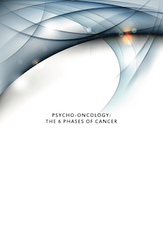Psycho-Oncology: Discover How Stress Causes Cancer
Phase 1 of Cancer: Inescapable Shock
Phase 2 of Cancer: Adrenaline Depletion
Phase 3 of Cancer: The Cancer Fungus
Phase 4 of Cancer: Niacin Deficiency
Phase 5 of Cancer: Vitamin C Depletion
Phase 6 of Cancer: Immune Suppression
EMF RADIATION AND CANCER
EMFs (or Electro-Magnetic Field) are a type of low-frequency radiation emitted from everything electrical around us: power lines, transformers, electrical wiring, computers, TVs, lights, clocks, appliances, etc. Recent studies have linked EMFs to increased leukemia, lymphoma, brain cancer, melanoma, breast cancer, miscarriage, birth defects, suicide, and recently Alzheimer's disease. Researchers have discovered that EMFs can suppress the pineal glands' secretion of melatonin, a hormone which controls our wake/sleep cycle, moods and task performance. Depressed melatonin levels are associated with mood changes, depression and psychiatric disorders. Melatonin also plays a critical cancer role, by increasing the phytotoxicity of the body's natural killer lymphocytes. Suppression of pineal gland function has been implicated in the etiology of breast, ovarian, prostate and melanoma cancers. Other studies have linked EMFs to decreased production of enzymes called "protein kinases" in human lymphocyte cells. This also indicates that EMFs can suppress the immune system. It is therefore important for the cancer patient to limit exposure to EMF radiation, and from regular sources of EMF radiation, including the computer, microwave oven, electric blanket, mobile and cordless telephone, in order to maintain a strong immune system.
WORLD RESEARCH LINKS EMF RADIATION TO CANCER
1. Office workers who used computer monitors (VDU's) had a significant reduction in circulating levels of melatonin over a course of the working day, according to a study by researchers Drs. Bengt Arnetz of the Karolinska Institute, and Mats Berg of the Karolinska Hospital in Stockholn Sweden. No such change was found during days at the office with no VDU use. According to the researchers; "This suggests that there is a direct impact from the electromagnetic environment of the VDU on levels of melatonin."
2. The idea that low level powerline frequency magnetic fields may reduce the pineal gland's production of melatonin and that melatonin's ability to suppress cancer cells is blocked by these fields, is called the "melatonin hypothesis". At the recent international conference, the Second World Congress for Electricity and Magnetism in Biology and Medicine, held in Bologna, Italy in June of 1997, it is mentioned in the program bulletin: "A number of experimental studies have been conducted to test the [melatonin] hypothesis. Although the literature is still evolving and consensus is being built, it is fair to say, a) there exists credible scientific support for the hypothesis and, importantly, b) this support encompasses in vitro, in vivo, and epidemiological research. The melatonin hypothesis, thus, currently represents one of the more well documented / tested interactions in the field of bio-electromagnetics."
3. Research reported in 1993 by the University of California, Berkeley, found that melatonin reduces the growth rate of human breast cancer cells (MCF-7) in culture, but that a 12mG 60 Hz magnetic field can block the ability of melatonin to inhibit breast cancer cell growth. This study was designed to define the parameters by which a 12 milli-Gauss (mG) 60 Hz magnetic field can block the inhibitory action of melatonin and Tamoxifen, a widely used drug treatment for breast cancer. They found that a 12 mG field can significantly reduce the growth inhibitory action of melatonin and Tamoxifen on human breast cancer cells (MCF-7) in culture. [J.D. Harland and R.P. Liburdy. Lawrence Berkeley National Laboratory, University of California, Berkeley, CA, USA.]
4. This study was specifically designed to attempt to replicate the previous (1993 University of California, Berkeley) study, with the cooperation of the originating laboratory. The results independently confirmed the previous study's findings that a) Melatonin can inhibit the growth of human breast cancer cells MCF-7 in culture, and b) A 12 mG 60 Hz magnetic field can completely block melatonin's oncostatic (cancer fighting) action. [C.F. Blackman, S.G. Benane, D.E. House and J.P. Blanchard. National Health & Environmental Effects Research Laboratory, U.S. Environmental Protection Agency, USA.]
5. This study was undertaken to test the hypothesis that ELF and VLF magnetic fields associated with Video Display Terminals (VDT's) - (computer & TV screens) - influence human breast cancer cell growth in vitro by altering melatonin's natural oncostatic activity. This hypothesis was based on the findings of the two previously mentioned studies. The conclusions of this study appear to suggest that 12 mG VDT magnetic fields also inhibit the oncostatic (cancer fighting) action of melatonin in vitro and that the magnetic field component was the operative factor in the 12 mG 60 Hz exposures. Preliminary data from two separate experiments indicated significant growth inhibition (33% and 22%) on day 6 in the 2 mG magnetic field conditions. [S.M.J. Afzal and R.P. Liburdy. Lawrence Berkeley National Laboratory, University of California]
6. At the June 1997 Bologna World Congress meeting, a paper presented by the Faculty of Medicine, University of Tokyo, specifically looked at melatonin levels and electric blanket use. The results of this study found that: "Nocturnal exposures to 50 Hz EMF generated from electric blankets...showed tendencies of suppressing peak value and/or delaying phase of melatonin rhythm in 7 of the 8 subjects.
7. A Boston University breast cancer study, led by Patrica Coogan, found a 43% increase in breast cancer among women with a high potential for occupational exposures to magnetic fields, notably those working with main-frame computers.
2. The idea that low level powerline frequency magnetic fields may reduce the pineal gland's production of melatonin and that melatonin's ability to suppress cancer cells is blocked by these fields, is called the "melatonin hypothesis". At the recent international conference, the Second World Congress for Electricity and Magnetism in Biology and Medicine, held in Bologna, Italy in June of 1997, it is mentioned in the program bulletin: "A number of experimental studies have been conducted to test the [melatonin] hypothesis. Although the literature is still evolving and consensus is being built, it is fair to say, a) there exists credible scientific support for the hypothesis and, importantly, b) this support encompasses in vitro, in vivo, and epidemiological research. The melatonin hypothesis, thus, currently represents one of the more well documented / tested interactions in the field of bio-electromagnetics."
3. Research reported in 1993 by the University of California, Berkeley, found that melatonin reduces the growth rate of human breast cancer cells (MCF-7) in culture, but that a 12mG 60 Hz magnetic field can block the ability of melatonin to inhibit breast cancer cell growth. This study was designed to define the parameters by which a 12 milli-Gauss (mG) 60 Hz magnetic field can block the inhibitory action of melatonin and Tamoxifen, a widely used drug treatment for breast cancer. They found that a 12 mG field can significantly reduce the growth inhibitory action of melatonin and Tamoxifen on human breast cancer cells (MCF-7) in culture. [J.D. Harland and R.P. Liburdy. Lawrence Berkeley National Laboratory, University of California, Berkeley, CA, USA.]
4. This study was specifically designed to attempt to replicate the previous (1993 University of California, Berkeley) study, with the cooperation of the originating laboratory. The results independently confirmed the previous study's findings that a) Melatonin can inhibit the growth of human breast cancer cells MCF-7 in culture, and b) A 12 mG 60 Hz magnetic field can completely block melatonin's oncostatic (cancer fighting) action. [C.F. Blackman, S.G. Benane, D.E. House and J.P. Blanchard. National Health & Environmental Effects Research Laboratory, U.S. Environmental Protection Agency, USA.]
5. This study was undertaken to test the hypothesis that ELF and VLF magnetic fields associated with Video Display Terminals (VDT's) - (computer & TV screens) - influence human breast cancer cell growth in vitro by altering melatonin's natural oncostatic activity. This hypothesis was based on the findings of the two previously mentioned studies. The conclusions of this study appear to suggest that 12 mG VDT magnetic fields also inhibit the oncostatic (cancer fighting) action of melatonin in vitro and that the magnetic field component was the operative factor in the 12 mG 60 Hz exposures. Preliminary data from two separate experiments indicated significant growth inhibition (33% and 22%) on day 6 in the 2 mG magnetic field conditions. [S.M.J. Afzal and R.P. Liburdy. Lawrence Berkeley National Laboratory, University of California]
6. At the June 1997 Bologna World Congress meeting, a paper presented by the Faculty of Medicine, University of Tokyo, specifically looked at melatonin levels and electric blanket use. The results of this study found that: "Nocturnal exposures to 50 Hz EMF generated from electric blankets...showed tendencies of suppressing peak value and/or delaying phase of melatonin rhythm in 7 of the 8 subjects.
7. A Boston University breast cancer study, led by Patrica Coogan, found a 43% increase in breast cancer among women with a high potential for occupational exposures to magnetic fields, notably those working with main-frame computers.
NEUTRALIZE EMF RADIATION WITH HIMALAYAN CRYSTAL SALT LAMPS
Melatonin has been shown in clinical studies around the world to inhibit cancer cell growth and the depletion of melatonin has also been shown in studies to stimulate cancer cell growth. EMF radiation, emitted from your computer, your TV, microwave, your mobile phone and cordless phone, etc, all contribute to lowering Melatonin levels within your body. It is important for the cancer patient to find a way to help neutralize EMF radiation emitted from everyday household and office electrical appliances. One of the most effective ways to do this is with Himalayan Crystal Salt Lamps. Salt crystal lamps are extremely beneficial for us, because they are natural negative ionisers. When the gentle heat from the lamp warms the crystal, they emit a negative electrical charge, thus ionising our atmosphere and interacting with our own bio-energetic field, and helping to neutralize harmful EMF radiation.





